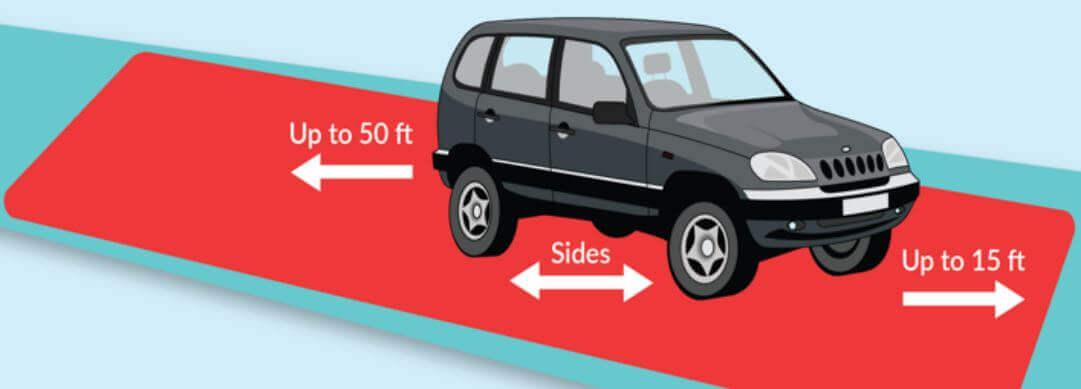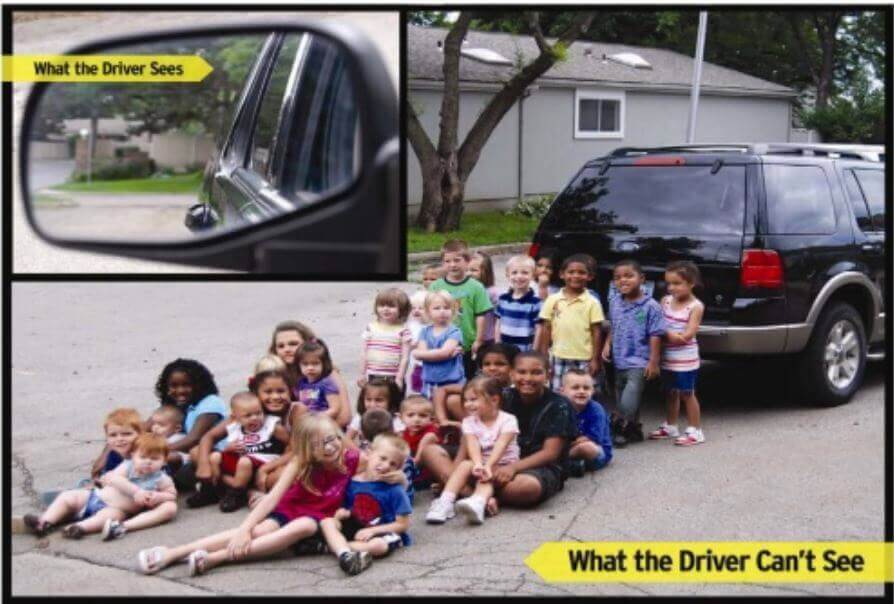Facts
In the U.S., 50 children are backed over EVERY WEEK because a driver could not see them. Rearview cameras can be installed on any vehicle to end these predictable tragedies.
Downloadable pdf - English Downloadable pdf - Spanish
Blindzones… every vehicle has them
A blindzone is the area behind, on the sides and in front of a vehicle where the driver cannot see even when looking back and using their rear and side view mirrors correctly.
- Average rear blindzone = 15 to 25 feet
- Shorter drivers = larger blindzones
- Over 60% of backovers involve a larger vehicle (truck, van, SUV)
Circumstances
- Backovers take place mainly in driveways and parking lots.
- In over 70% of these incidents, a parent or close relative is the driver behind the wheel.
- Bye-Bye Syndrome™: Children don’t want to be left behind when they hear the words ‘bye-bye.’ Many times children follow behind the person who is leaving. The driver is unaware the child snuck out, thinking they are still safe inside. The child stands behind the vehicle where they cannot be seen and is backed over.
Contributing Factors
You cannot avoid hitting something you literally cannot see.
- Most drivers are unaware of the very large, dangerous blindzone that is found behind ALL vehicles.
- Children do not understand the danger of a slow moving vehicle; they believe if they see the vehicle, the driver can see them.
- Children do not recognize boundaries (property lines, sidewalks, driveways or parking spaces) and are very impulsive.
Age
- The predominant age of backover victims is one-year-old. (12-23 months). Toddlers have just started walking/running at this age, testing the limits and trying new things.
- Children younger than 5-years-old are at the most risk, but children of all ages can be backed over.
Statistics
According to Kids and Car Safety, at least 50 children are backed over in the U.S. every week – 48 are treated in hospital emergency rooms and 2 die. In 2015, NHTSA reported 284 fatalities and 12,000 injuries occurred to backovers.*
Thousands of children are seriously injured or killed every year because a driver backing up was not able to see them behind their vehicle. Many elderly people are also backed over by vehicles.
Rear Visibility Standard:
To reduce the risk of devastating backover crashes involving vulnerable populations (especially very young children), Kids and Car Safety and their partners, worked to prevent these predictable and preventable tragedies for over a decade. A rear visibility standard was issued on April 7, 2014 as mandated by the Cameron Gulbransen Kids Transportation Safety Act. The Department of Transportation (DOT) issued the final rule for all passenger vehicles weighing less than 10,000 pounds. The standard specifies the area behind a vehicle which must be visible to the driver when the vehicle is placed into reverse. In order to meet this standard, all motor vehicles sold or leased in the U.S. starting in 2018 now come with a rearview camera as standard equipment.
Kids and Car Safety is beginning to see rearview cameras reduce backover crashes. Education and awareness of backover crashes will continue to be critical for decades because most older-model vehicles do not have rearview cameras. All vehicles can and should be retrofitted to include rearview technology.
Prevention/Safety Tips:
Drivers should heighten their awareness before engaging a vehicle into reverse; especially when children are present. Young children are impulsive and unpredictable; still have very poor judgment and little understanding of danger.
Kids and Car Safety urges everyone to install a rearview camera and sensors on their vehicle. Many drivers believe they have to wait to purchase a new vehicle to have this safety feature but a rearview camera, 360-degree camera system and/or sensors can be installed on ANY vehicle.
- Install door alarms on the doors leading to outside your home so you know any time someone is leaving the home. Many toddlers sneak out of the home and are then run over. You can also use childproofing door knob and handle covers to prevent children from leaving unnoticed.
- Create habits to ensure children are directly supervised every time someone is arriving or leaving the home. This is when most tragedies at the home occur.
- Example of a routine you can implement at your home – Before leaving the home, verbally and visually confirm that all children are in direct contact with the adult who is actively watching them. The supervising adult should stay in direct contact with all children until the person leaving is safely out of sight.
- Walk completely around your vehicle scanning the area for children and pets prior to moving a vehicle. If you see or hear children, be sure they are directly supervised by an adult.
- If you need to move a vehicle without another adult present, make children move away from your vehicle to a place where you can clearly see them or put them in the car with you before moving the car.
- Never allow young children to walk through parking lots. Young children should always be carried or placed in a stroller or shopping cart in parking lots. Even holding hands cannot prevent a child from darting away.
- Do not allow children to play in driveways, cul-de-sacs or parking lots unsupervised.
- Trim landscaping around the driveway to ensure drivers can see the sidewalk, street and pedestrians clearly when backing out of their driveway. Pedestrians also need to be able to see a vehicle pulling out of the driveway.
- Roll down the driver’s side window when backing so you can hear if someone is warning you to stop.
- Be especially careful about keeping children safe in and around cars during busy times, schedule changes and periods of crisis or holidays.
Tips to teach children
Talk to your children about the dangers of vehicles, but never rely on them to protect themselves. Even children who know about vehicle dangers can place themselves in dangerous situations. It only takes one brief moment of distraction or a ball rolling out into the path of vehicle. Children of all ages have been run over and injured or killed by vehicles.
- Parked vehicles might move. Warning signs that a vehicle might move include a running engine, reverse lights (white lights) and brake lights (red lights) or smoke coming from the exhaust pipe on a vehicle.
- The driver may not be able to see you.
- Never walk behind or in front of a running vehicle.
- Never play in parking lots, driveways, streets or cul-de-sacs unsupervised.
- When walking on the sidewalk, watch for cars pulling into or leaving driveways.
Please share these important safety tips with your childcare providers, teachers, relatives, friends, family and neighbors…
These precautions can save lives.
*Source: Non-Traffic Surveillance: Fatality and Injury Statistics in Non-Traffic Crashes in 2015, DOT HS 812 515, April 2018



